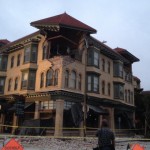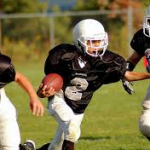Archive for September, 2014
Earthquake First Aid Kit Items
Posted by: | Comments The recent earthquake in the Napa area of California reminds us that a significant earthquake is always a present danger. One that we should be taken seriously and we should take proactive actions to prepare and gather supplies ahead of time.
The recent earthquake in the Napa area of California reminds us that a significant earthquake is always a present danger. One that we should be taken seriously and we should take proactive actions to prepare and gather supplies ahead of time.
If the Loma Prieta earthquake in 1989 taught us anything, is that medical and municipal service will not be readily available and we may need to fend for ourselves for several days.
Creating a first aid kit should be one of your first and on-going priorities. Food and water may be in short supply immediately after a major event. You should plan to have at least 3 days of supplies on-hand. Here are some suggestions on items you should be planning for:
Food
- Can foods work best during an emergency. Most don’t need to be cooked and can be eaten right out of the can. Make sure to store a can opener with you emergency food supplies.
- Eat frozen foods or items from your refrigerator first. Without power these foods will not last long.
Water
- Plan on at least 1 gallon of water per person per day. Your home offers several locations for drinkable water.
- Water drained from the water heater. (45 gallons).
- Water from the tank of the toilet (not the bowl).
- Melted ice cubes.
- Canned fruit and vegetable juices.
- Water from swimming pools and spas can be used for personal hygiene, cleaning, and related uses, but not for drinking.
Drugs/Medications
- Hydrogen peroxide to wash and disinfect wounds
- Antibiotic ointment
- Aspirin and non-aspirin tablets
- Prescriptions and any long-term medications (keep these current)
- Diarrhea medicine
- Eye drops
Dressings
- Bandage strips Cotton-tipped swabs
- Ace bandages Adhesive tape rolls
- Dressings & Roller gauze Sanitary napkins
Other First Aid Supplies
- Scissors
- Tweezers
- Bar soap
- Tissues
- Sunscreen
- Small plastic bags
- Iced or cold packs
For additional information, please feel free to download our free “Earthquake Safety Ebook.” http:///www.cprescue.com/earthquake-safety-tips/
Get Ready for the Cold and Flu Season
Posted by: | Comments Last year’s Cold/Flu Season reported 105 childhood deaths. Most colds and flu’s are due to a virus and the use of antibiotic will not work. Antibiotics are used to treat bacterial infections. Many secondary viral infections are bacterial and need antibiotics. These secondary viral infections include: ear infections, tonsillitis, pneumonia, bronchitis, strep and whooping cough.
Last year’s Cold/Flu Season reported 105 childhood deaths. Most colds and flu’s are due to a virus and the use of antibiotic will not work. Antibiotics are used to treat bacterial infections. Many secondary viral infections are bacterial and need antibiotics. These secondary viral infections include: ear infections, tonsillitis, pneumonia, bronchitis, strep and whooping cough.
With the cold and flu season almost upon us, we should begin taking precautions. To understand the difference and reduce the possibility of acquiring either, read the following 10 suggestion.
- Cold germs can survive on bathroom sinks, kitchen counters and doorknobs for up to 3 hours. Sanitize these areas regularly.
- Colds are most contagious before symptoms begin to appear.
- There are over 200 viruses that can cause a cold.
- Stress is the number one cause to increased susceptibility to a cold or flu infection.
- Chicken soup does help fight colds. It breaks up nasal congestion and the lean protein (chicken) helps boost your strength to fight off the illness.
- Drink plenty of fluids to keep hydrated and to flush out your system.
- Though you can run a mild fever with a cold in most cases a fever, especially a high fever, will indicate its flu not a cold.
- Some flu’s are bacterial and must be treated with antibiotics. If left untreated, it could lead to pneumonia, a life threatening respiratory illness.
- Get a flu shot. Flu shots do not carry an active flu virus in them. You can’t get the flu from taking a flu shot.
- Protect yourself from a cold or flu by washing your hands regularly, several times a day, with soap and water. Hand sanitizers can also help when soap and water are not available.
See a physician if you or your family member begins to feel ill. They can do test to determine if the cold / flu is viral or bacterial.
Earthquake Preparedness with Baby
Posted by: | Comments CPRescue has been asked to speak for the Blossom Birth Organization at the Whole Foods Market in Palo Alto. We will be conducting a half hour session about “Earthquake Preparedness with Baby.” Please see Blossom Birth’s announcement below:
CPRescue has been asked to speak for the Blossom Birth Organization at the Whole Foods Market in Palo Alto. We will be conducting a half hour session about “Earthquake Preparedness with Baby.” Please see Blossom Birth’s announcement below:
Blossom is honored to be the recepient of Whole Foods Market Palo Alto’s Nickels for NonProfits, this quarter! Everytime you bring your own bags to shop at the Palo Alto store, please be sure to say “donate” at the checkout counter, thank you! Also join us on Friday, Sept 12 from 10:00am until noon to learn helpful tips for your newborn! Speakers include:
- Mike Willson, CPRescue on Earthquake Preparedness with Baby
- When: Friday, September 12th, 2014
- Time: 10:30am
- Location: Whole Foods Market, 774 Emerson St, Palo Alto
Child Cardiac Arrest in Sports
Posted by: | Comments Can a child suffer from cardiac arrest while playing sports? Actually yes, there have been recorded incidents in football, basketball, hockey, karate and even in soccer. Before everybody begins pulling their child from all sports, let take a look at this very rare condition.
Can a child suffer from cardiac arrest while playing sports? Actually yes, there have been recorded incidents in football, basketball, hockey, karate and even in soccer. Before everybody begins pulling their child from all sports, let take a look at this very rare condition.
“Commotio Cordis” or a lethal disruption of a child’s heart rhythm, happens when a child receives a blow to the chest at a very specific time during a heartbeat. Usually within a specific 10-30 milliseconds time period. After the heart squeezes out blood, it goes through a resetting process before the next contraction. If a child receives a blow to the chest during this resetting period, the heart can begin to quiver. This quivering action is called ventricular fibrillation and in most situations, the method to cure this condition is called defibrillation, which is done with the use of an AED (Automated External Defibrillator).
Though this condition is rare it is best to have coaches and other personnel trained in CPR. Make sure 911 is called immediately and if possible, have your organization consider purchasing and having an AED available.
Studies have shown that resuscitation rates increase dramatically when an AED is used within three minutes of a child going into ventricular fibrillation. The longer it takes for this to happen the chances of survival can decrease sharply. In most cases, waiting for the ambulance to arrive, may be too late.
Commotio cordis is scary, but very rare and is unlikely to happen to your child. Encourage your children to play sports and other physical activities, just be prepared to act in case of an emergency.







